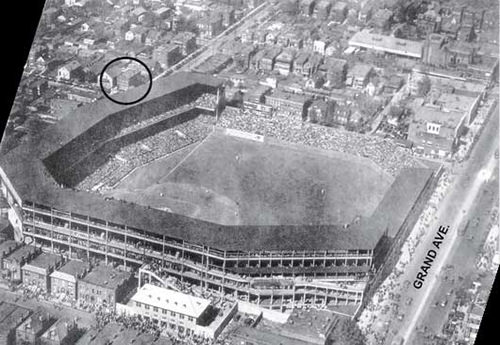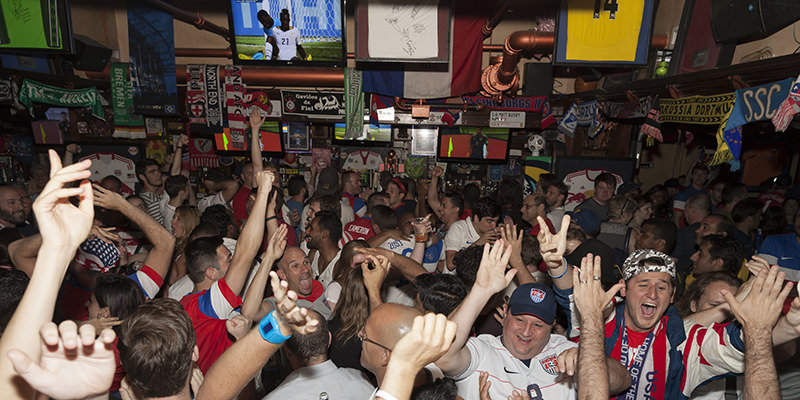Sports bars might not be your thing, especially if you don’t like sports, or don’t like them enough to endure a wall of flat- screen TVs and a lot of sports-themed profanity. But for many, sports bars have become a way to gather with like-minded fans (and sworn sports enemies) and catch a game. Plus a lot of beer and mediocre but still somehow delicious nachos.
So where did this entertainment/intoxication hybrid come from? How did watching a game at the bar morph into the glitzy, autograph- and jersey-packed sports and booze fun house we know and love today? The sports bar’s actually older than you think, especially if you consider the fact that gathering to drink and talk sports is a simple tradition dating back to the earliest European pubs. But in terms of the first real sports bar in America, there’s a specific history. Two, actually.
As one story goes, the first modern American sports bar was called Legends, opened in Long Beach, California in 1979, the brainchild of former L.A. Rams offensive lineman Dennis Harrah. (A good post-career move if you’re not making ridiculous amounts of money like Tom Brady.) Like most every sports bar today, Legends eventually filled up with memorabilia, and not just NFL-related. It had everything from autographed shoes to Mohammed Ali’s boxing gloves to an actual Indy race car suspended (God we hope) carefully from the ceiling.
What really separated Legends back in the day, and what theoretically classifies it as the first “modern” American sports bar, was its satellite feed. According to its website, “Legends was the first establishment to use satellite technology to broadcast live sporting events from around the world.” If you hate a sports bar, you probably just see that massive bank of TVs as so much visual noise — clashing sportscaster metaphors interrupted by a lot of beer commercials. But for sports fans, getting live feed of games, especially on Legends’ supposedly “largest HD quality projection television in the United States,” means you can watch sports not broadcast locally. Sure, you might have to endure a lot of noise entirely unrelated to your sport of choice, but you also get to eat wings and, of course, drink beer.
But even if Legends does call itself “the granddaddy of all sports bars,” it might actually have a granddaddy of its own. Palermo’s in St. Louis has a serious claim to being the “first” real American sports bar, since it was opened on the day the Volstead Act was repealed in 1933. Basically, as soon as it was legal to sell booze again in the United States, this family-run tavern was doing it.

Before it was a sports bar, Palermo’s was part of a larger family business located across the street from Sportsman’s Park, former home to the Cardinals and Browns. In fact, 10 years before they opened their tavern, Paul Palermo actually built what might be the first hot dog stand in the States. (And yes, concessions seemed insanely cheap: 5 cents for a small hot dog, 10 cents for a large, because everything was simpler back then.) The family also ran a confectionary (not just a candy store, more like a general supply store) and a small restaurant where Mary Palermo would cook up Sicilian favorites. But once Prohibition was repealed, the restaurant took on new life as a tavern.
Before prohibition, Paul Palermo ran a string of successful bars in St. Louis. Once Prohibition was repealed, the booze started flowing again and Palermo’s restaurant transitioned into a bar and, slowly but surely, a “sports bar.” Plenty of people go to bars and pubs to watch or just talk about the game, and even though that’s how Palermo’s started life — a watering hole where patrons could crowd around the radio and listen in — by the late 1940s, the sports vibe started taking center stage. The fact that televisions were becoming more common didn’t hurt.
Apparently, “it all started when Jimmy [Palermo, a former umpire] was given several letter-sized black and white bust photos of the Browns players.” Jimmy had actually been a part of the Browns organization from 1927 to 1941. Once those photos were hung, more came in (if you build it, they will come, ahem). By the 1950s, Palermo’s remodeled itself entirely around the sports theme, decked out “with game-used equipment from all 16 [then] Major League teams including uniforms, caps, gloves, balls, and hundreds of cracked bats.”
Interesting point of connection: when August Anheuser “Gussie” Busch bought the St. Louis Cardinals in 1953, Palermo’s made Busch’s their house draft beer. Touchdown for macro beer.
Header image via lev radin / Shutterstock.com

